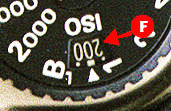The top panel is
one of the two command centers and most of the operational controls are located at
the right hand side for single hand operation. That is where the shutter release
button which also acts as the meter-on switch when you depress halfway. The shutter
release button is threaded in the middle so it can accept a cable release for long
time or slow speed photography. The frame counter is just above the film advance
lever and next to the shutter release button. It will reset to '0' whenever the film
back has been spring open and causing the pin to reset. ![]()
 |
|
Note: FM-10 is a mechanical camera, it does not have too many fancy gadgets. Like the FM or any other models within the FM2 series, the FM10 is a mechanical camera. The camera requires battery to power the metering circuit, but the shutter is mechanically timed. In other words, if the battery run out on you in the mid of shoot, you'll only lose the metering capabilities of the built-in meter. However, in which case, the shuttle still works, you will have to rely on other means of metering 9hand held meter or experience) to determine the exposure. (For some thoughts on battery issues, check this out) |
| What does all those
dots and numbers in the frame counter (T) mean ? They are the exposure
number. With
'S',
'12', '20', '24'
and '36' marked
in red to indicate popular length of common film used. S..1..4.6.8.10.12.14.16.18.20.22.24.26.28.30.32.34.36. Those days of the early years in photography, we always tried to screeze a few frames out of the 36 exposure roll by just slotting the film leader in the film take up spool. You may also try but care should be taken to ensure the film has been properly taken up. Before they brought auto DX film coding into SLR design, there is no other way to confirm whether the film has been taken up smoothly other than by the feel of a slight resistant when you advance the film and observing the rewind crank will rotate in opposite direction. |
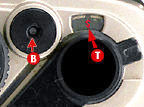 |
Helper note: It will be easier to have a map for cross reference, Click here to open a new browser window for a Main Reference Map page.
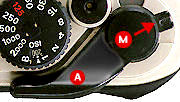 |
The tiny lever located just next to the film advance lever (A) is the multiple exposure lever (M). Used in the original FM in 1977 and improved with the Nikon FE in 1978, the multiple exposure operation with the Nikon manual focus bodies is a real joy to use. No more pressing the rewind button underneath the camera for uncertainty of operation and it is dead accurate in registration for any amount of duplicating exposures. |
However, since such operations may require certain amount of exposure compensation and experience would count when you are working with tight exposure latitude film like slides. The advantage of having the lever just next to the film advance lever is that you can operate it with just a single hand and can confirm the frame is not advancing by viewing and monitoring the frame counter just above it. The shutter release button controls the speed of the shutter curtain. That is essentially one of the two main components for an exposure process (oohs.. may be I have to include the film as well,,, a little credit to Kodak, Fuji, Agfa and Konica etc..). The other element is being controlled by the diaphragm inside the lens. Both (camera shutter and lens diaphragm) regulates the amount of light entering onto the unexposed film inside. The speed of the shutter is controlled by selecting the various shutter speed settings engraved on the dial. There are 13 settings on the shutter speed ring.
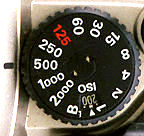 |
'B', '1', '2', '4', '8', '15', '30', '60', '125', '250', '500', '1000'. 'B' stands for 'bulb', a setting that opens the shutter curtain as long as the shutter release button is being depressed and the mechanism will release and activate the curtain to close as soon as your finger (or cable release) is removed. There is only one speed setting marked in red "125". This is the reminder for flash photography. The maximum synchronization speed for the FM-10 to sync with an electronic flash is 1/125 sec. (FE-10 has a slower maximum sync speed of 1/90 sec). The shutter speed dial has another function other than controlling the shutter speeds. Just in between the '1' (One second) speed setting and 'B' (Bulb), there is a tiny window for adjusting the ASA film speed (F) of the film in use. |
|
|
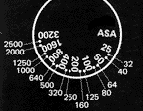 |
The FM-10 has a rather generous ASA/ISO Film Speed range from ASA/ISO 25-32000 manually set by 1/3 step increments. It is the same as other competitive models such as the Olympus OM2000. The Original FM has a broader 12 to 3200 range while the current FM2(n)'s range is even higher at ASA/ISO 12-6400 ! |
The FM-10 still retaining the safety feature of avoiding accidental shifting of the film speed. You have to pull the outer ring in order to rotate left and right to change the film speed settings. The ASA range is consider sufficient since the camera is originally designed mainly targeted at the novice user market.
 |
Right in the middle of the pentaprism is the location of the accessory shoe. Frankly, I thought Nikon could have drawn a better spec for FM-10 to handle flash photography. I don't expect TTL flash exposure control to be made available in the entry mechanical camera model such as the FM-10 (Not possible ? |
Wait till you see a mechanical but ridiculously high price Olympus OM-3 Ti). But flash feature was made so rudimentary that it is in fact a bare bone offering in the most basic form. Just a hot shoe contact! There is not even a flash ready light nor auto sync speed setting terminal on the accessory shoe. I don't want to sound nasty here, but since the FM-10 is not designed to accept any automatic film advance accessory such as Motor Drive, users are denied with some great possibilities in other system accessories designed for remote and macro photography. The accessory shoe functions more like a plain flash shoe since it has reverted back to stone age design and has little usage to take advantage of those accessories. Despite the flaw, you can still use any shoe mount flash either in manual or electronic auto flash mode. Multiple flashes operation is still possible but only limited to slave units mounted on remote flash units. You cannot use any older flash unit (or some high powered handle flash that require a flash cable to plug into the PC terminal) that uses sync cable because the FM-10 has NO PC terminal.
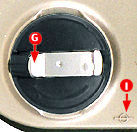 |
The left hand side of the camera is occupied by a sole film rewind knob. The top panel of the camera is suspiciously made of molded plastic, as evidenced by the embossed symbol of the film plane indicator ( i). The indicator was very useful those days for macro or duplicating works of which Nikon has a standard lens flange to film plane distance of 46.5mm. But since modern cameras have a lot of auto accessories designed specifically for macro or close up photography, such measurement is not necessary anymore. However, most SLR still retain this symbol to provide the exacting location of the film plane inside the camera. |
As
explained earlier,
the film rewind knob has removed the safety lock feature found commonly on many other
Nikon manual focus bodies, Thus, once you unfold and pull up the rewind crank (G)),
the film back will spring open. Obviously, when loaded with a fresh film roll, before
you attempt to pull the film leader to the film take up spool, push the rewind fork
and lock the film cartridge in place inside the film compartment. This should complete
the top portion of the FM-10. Next, we will move to the base section and followed
by the back section of the camera.
| Previous | Next | 1/6
Base, Back, Eyepiece,
Focusing Screen, Viewfinder, exposure information
| Back | to Index Page of FM-10
| Back
| to Main Index Page
of FM Series Models
Camera Instruction Manual | Other Issues relate to Nikon FM-10.
| Message Board | for
your favourite Nikon
FM Series SLR models
| Message
Board | for your Nikon
Optics in a shared environment
| Message Board | Specifically for Dispose or Looking for Nikon/Nikkor
Photographic Equipment
Standard
production Nikon FM Series models:-
Nikon FM | Nikon FM2 | Nikon FM2n | Nikon FM10 | Nikon FM3a |
Known
variants:-
Nikon
FM Gold
| Nikon
FM2/T
| Nikon
FM2N Tropical Set
| Nikon
FM2/T Limited Edition
| Nikon
FM2N LAPITA
|
Nion
FM2n Millennium 2000
Shared Resources: MD-11 | MD-12 | Focusing Screens | Titanium Shutter | Flash Units -SB-16 | SB-15 | SB-10 or other Options | Databack | Nikkor lens mount (related info)
Others:- Nikon AF-TTL Speedlights | SB-20 (1986) | SB-22 (1987) | SB-23 | SB-24 (1988) | SB-25 (1991/2) | SB-26 (1994) | SB-27(1997) | SB-28 (1997) | Nikon SB-29(s) (2000) | Nikon SB-30 (2003) | Nikon SB-600 (2004) | Nikon SB-800 (2003) Nikon AF-TTL Speedlight DX-Series: Nikon SB-28DX (1999) | SB-50DX (2001) | SB-80DX (2002)
Nikon
BC-flash Series |
Original
Nikon Speedlight
SB-2
| SB-3
| SB-4
| SB-5
| SB-6
| SB-7E
| SB-8E
| SB-9
| SB-E
| SB-10
SB-11
| SB-12 | SB-14 | SB-140 UV-IR| SB-15 | SB16A | SB-17 | SB-18, SB-19 | SB-21A (SB-29) Macro flash | Flash Accesories | SF-1
Pilot Lamp
Instruction
Manual: Nikon FM (HTML | PDF) | Nikon FM-10 (HTML) | Nikon FM2n's
User's Manual
available only in HTML format (6
parts) | Nikon
FM3A
(HTML)
Specifications: Nikon FM, FM-10, FM2, FM2n and FM3A / Main
Reference Map: (HTML) Nikon FM, FM2, FM-10, FM2n (Applicable
to FM2T, FM2 "Year of the Dog"; Millennium 2000") and Nikon FM3A
| Nikon F | Nikon F2 | Nikon F3 | Nikon F4 | Nikon F5 | Nikon F6 | Nikkormat / Nikomat | Nikon FM | Nikon FE/ FA | Nikon EM/FG/FG20 | Nikon Digital SLRs | Nikon - Other models |
Nikon Auto Focus Nikkor lenses:- Main
Index Page
Nikon Manual Focus Nikkor lenses:- Fisheye-Nikkor Lenses - Circular | Full Frame |
Ultrawides Lenses - 13mm15mm18mm20mm | Wideangle Lenses - 24mm28mm35mm | Standard Lenses - 45mm 50mm 58mm | Telephoto
Lenses - 85mm105mm135mm180mm & 200mm | Super-Telephoto Lenses - 300mm 400mm 500mm 600mm 800mm 1200mm |
 Index Page |
Special
Application lenses: Micro-Nikkor Lenses - 50mm~55mm -60mm 85mm -105mm 200mm Micro-Zoom 70-180mm Perspective Control (PC) - 28mm 35mm PC-Micro 85mm Dedicated Lenses for Nikon F3AF: AF 80mm f/2.8 | AF 200mm f/3.5 EDIF Depth of Field Control (DC): 105mm 135mm Medical Nikkor: 120mm 200mm Reflex-Nikkor Lenses - 500mm 1000mm 2000mm Others: Noct Nikkor | OP-Nikkor | UV Nikkor 55mm 105mm | Focusing Units | Bellows-Nikkor 105mm 135mm Nikon Series E Lenses: 28mm35mm50mm100mm135mm | E-Series Zoom lenses: 36~72mm75~150mm70~210mm |
MF Zoom-Nikkor Lenses: 25~50mm | 28~45mm | 28~50mm | 28~85mm | 35~70mm | 36~72mm E | 35~85mm | 35~105mm | 35~135mm | 35~200mm | 43~86mm | 50~135mm | 50~300mm | 70~210mm E | 75~150mm E | 80~200mm | 85~250mm | 100~300mm | 180~600mm | 200~400mm | 200~600mm | 360~1200mm | 1200~1700mm
Tele-Converters: TC-1 | TC-2 | TC-200 | TC-201 | TC-300 | TC-301 | TC-14 | TC-14A | TC-14B | TC-14C | TC-14E | TC-16 | TC-16A | TC-20E
Recommended links to understand more technical details
related to the Nikkor F-mount and production Serial Number:
http://rick_oleson.tripod.com/index-153.html by: my
friend, Rick Oleson
http://www.zi.ku.dk/personal/lhhansen/photo/fmount.htm by: Hansen,
Lars Holst
http://www.mir.com.my/rb/photography/hardwares/nikonfmount/lens2.htm
http://www.photosynthesis.co.nz/nikon/serialno.html
W A R N I N G: The New G-SERIES Nikkor lenses have no aperture ring on the lens, they CANNOT ADJUST APERTURES with any of these manual focus Nikon FE series SLR camera models; please ignore some portion of the content contained herein this site where it relates.
|
Back | Main Index Page of Nikkor Resources
|
Back | Main Index Page of Pictorial
History of Nikon SLRs
| Message Board | for your Nikkor optics ("shared" because I do wish some of you to expose to other's perspective as well. Isn't it a sad sate to see photography has to be segmented into different camps from the use of various labels)
about this photographic web site
Home - Photography in Malaysia |
Credit: To all the good people who has contributed their own experience, resources or those who are kind enough granting us permission to use their images appeared in this site. Mr. MCLau®, who has helped to rewrite some of the content appeared this site. Chuck Hester® who has been helping me all along with the development of all these Nikon websites;LarsHolst Hansen, 'Hawkeye' who shares the same passion I have; Ms Rissa, Sales manager from Nikon Corporation Malaysia for granting permission to use some of the official content; TedWengelaar,Holland who has helped to provide many useful input relating to older Nikkor lenses; Some of the references on production serial numbers used in this site were extracted from Roland Vink's website; HiuraShinsaku from Nikomat Club Japan. t is also a site to remember a long lost friend on the Net. Note:certain content and images appeared in this site were either scanned from official marketing leaflets, brochures, sales manuals or publications published by Nikon over the years and/or contribution from surfers who claimed originality of their work for educational purposes. The creator of the site will not be responsible for may discrepancies arise from such dispute except rectifying them after verification."Nikon", "Nikkormat", "Nippon Kokagu KK" & "Nikkor" are registered tradename of Nikon Corporation Inc., Japan. Site made with an Apple IMac.

